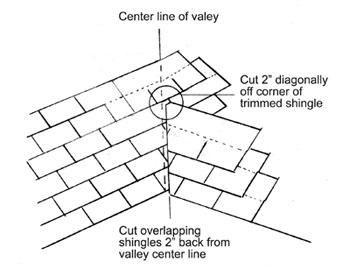Thanks Bryce, that was helpful. We get all of that here. My directive was to have a qualified Roofing contractor evaluate and repair as necessary.
Of course, California cut. Because we develop all the short cuts. ![]()
There is absolutely nothing wrong with the install.
We do visual inspection. If you refer that you will look foolish.
If you would have looked at where the valley meets the fascia you “may” have seen flashing which “may” have run the length of the valley. That is the way I do it…
This may be true where you are at, but I have done California cut with 3-tabs for 30+ years here in California (permitted) with never a problem.
IN FLORIDA. California cut valleys are one of my pet peeves. It’s evidence that the installer doesn’t have enough knowledge of roofing systems. While it may look pretty, it’s not a recommended method. A closed cut valley with clipped corners performs the best.
Here’s my narrative:
“This roofing system contains California Closed-Cut Valleys. The National Roofing Contractors Association (NRCA) does not recommend this type of valley installation in climates with heavy rainfall. While it is not feasible to re-work the existing valleys on this system, they should be monitored during heavy rains and repaired or replaced if needed. For more information, please see the information sheet in the attachments section of this report.”
I include the following photo and .pdf attachment.
You may well have if you ignored the manufacturer’s installation instructions which say not to do it.
(Ref: CertainTeed Shingle Applicator’s Manual).
We all know how well city permit inspectors inspect roof covering installations.
Maybe they write different installation instructions for Californians??? You’ll have to research.
I have not come across one of this type of coverings. M. Larson shows two schemes: one shows the tab minus a clipped corner, the other scheme does not clip the corner (or so it appears).
Someone, please, tell me: are all corners clipped on one side of the valley, and if so, why?
Thank you.
I would never use 3-tabs on a California cut valley. The cutouts are one thing, but there is also no adhesive strip at the bottom of a 3-tab. Dimensional shingles have that adhesive strip on the bottom back side to seal the valley and hold the edge down in high winds. Also, lining up the corners to the starter shingle would throw off the alignment of the rest of 3-tab shingles…I don’t know how you made that work out.
Me Neither.
/COLOR]
This can be said for all areas of the roof when it comes to 3 tab shingles. When I complete the roof the last thing I do is seal all vents, flashing and any California cut valleys with approved roof mastic (Henry’s). I’m in southern California we do not have hurricanes and/or excessive seasonal rain fall. I think our total rain fall to date is less than 9”. Our weather conditions and roofing requirements will be different than those of other areas.
I have installed countless 3 tab shingle roofs on track, factory and custom built homes that have been inspected by state inspectors, not county inspectors and never a problem with a California cut valley. I totally agree that Dimensional shingles are a far superior product than 3 tab shingles hand down.
In southern California, I saw many, many homes built using California Cut Valleys with no problems. On many housing tracts it’s been the accepted method because it’s cheap, simple, and it’s hard to make a mess of it. On the other hand, how many closed-cut valleys have you seen with valley shingles that look like they were cut by a drunken blind man?
California Cut Valleys might be perfectly acceptable in CA where it’s relatively dry, and more of a problem in a climate with seasonal heavy rains. I’m not sure there’s one answer for all of North America.
The bottom line is it is not an accepted installation process.
It is in Southern California.
Depending on where you live, yes it is.
We probably get more rain than most areas and a California Cut is quite common.
It is at 10,000 feet in Park City, Utah. No problem with snow load.
Thats not true.
I have my roofers put flashing under all enclosed valleys…
Just because you can’t see the flashing doesn’t mean it is incorrect.
the corners of the shingles are clipped back it is meant to be less interference with water flow

